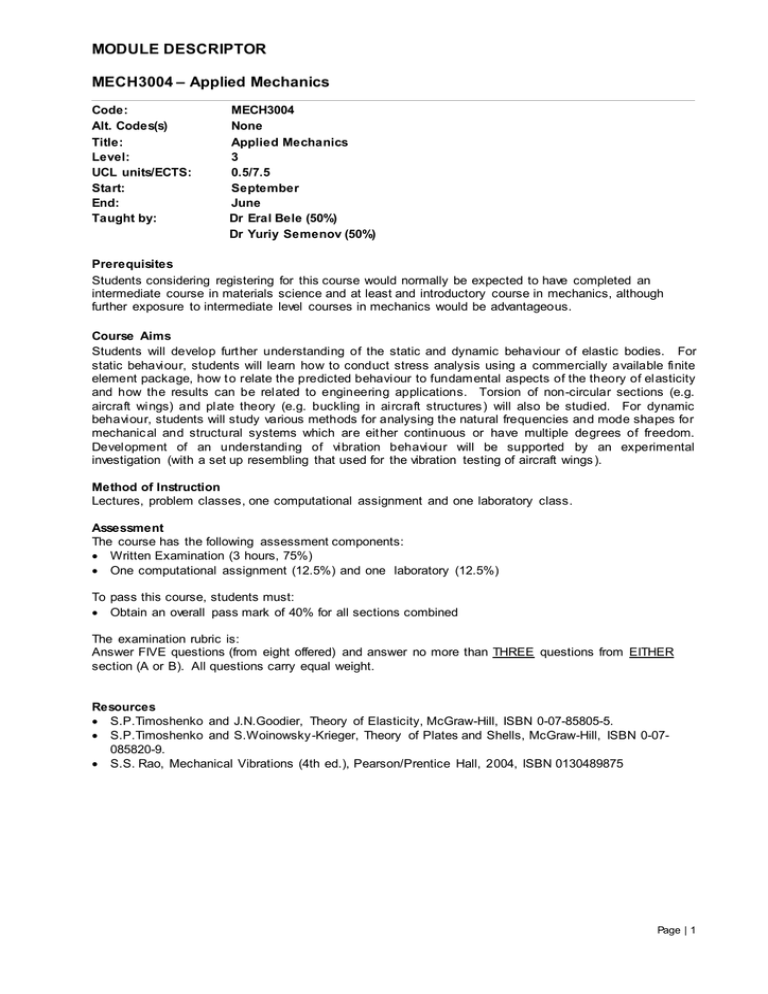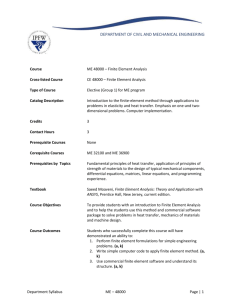
MODULE DESCRIPTOR
MECH3004 – Applied Mechanics
Code:
Alt. Codes(s)
Title:
Level:
UCL units/ECTS:
Start:
End:
Taught by:
MECH3004
None
Applied Mechanics
3
0.5/7.5
September
June
Dr Eral Bele (50%)
Dr Yuriy Semenov (50%)
Prerequisites
Students considering registering for this course would normally be expected to have completed an
intermediate course in materials science and at least and introductory course in mechanics, although
further exposure to intermediate level courses in mechanics would be advantageous.
Course Aims
Students will develop furt her understanding of the static and dynamic behaviour of elastic bodies. For
static behaviour, students will learn how to conduct stress analysis using a commercially available finite
element package, how t o relate the predicted behaviour to fundamental aspects of the theory of elasticity
and how the results can be related to engineering applications. Torsion of non-circular sections (e.g.
aircraft wings) and plate theory (e.g. buckling in aircraft structures ) will also be studied. For dynamic
behaviour, students will study various methods for analysing the natural frequencies and mode shapes for
mechanic al and structural systems which are eit her continuous or have multiple degrees of freedom.
Development of an understanding of vibration behaviour will be supported by an experimental
investigation (with a set up resembling that used for the vibration testing of aircraft wings ).
Method of Instruction
Lectures, problem classes, one computational assignment and one laboratory class.
Assessment
The course has the following assessment components:
Written Examination (3 hours, 75%)
One computational assignment (12.5%) and one laboratory (12.5%)
To pass this course, students must:
Obtain an overall pass mark of 40% for all sections combined
The examination rubric is:
Answer FIVE questions (from eight offered) and answer no more than THREE questions from EITHER
section (A or B). All questions carry equal weight.
Resources
S.P.Timoshenko and J.N.Goodier, Theory of Elasticity, McGraw-Hill, ISBN 0-07-85805-5.
S.P.Timoshenko and S.Woinowsky-Krieger, Theory of Plates and Shells, McGraw-Hill, ISBN 0-07085820-9.
S.S. Rao, Mechanical Vibrations (4th ed.), Pearson/Prentice Hall, 2004, ISBN 0130489875
Page | 1
Content
Static behaviour (Dr Kevin DrakeEral Bele - Autumn Term)
1.
Elasticity theory
Plane stress and plane strain
Problems in rectangular coordinates
Problems in polar coordinates
Stress concentrations
2. Finite element method
Beam elements
Plane elements
3.
Torsion
Non-circular cylindrical sections
Membrane analogy
Approximate solutions for thin-walled sections
4.
Plates
Rectangular plates
Navier’s solution
Combined in-plane and lateral loading
Energy methods
5. Coursework
An investigation of stress concentrations in an elastic body using the finite element analysis package
ANSYS. Comparison of the computational results with published guidance.
Dynamic behaviour (Prof Gert van der HeijdenDr Yuriy Semenov – Spring Term)
1.
Analytical dynamics
Generalised coordinatees
Generalised forces
Virtual displacements
Lagrange’s equations of motion
2.
Multi-degree of freedom systems
Finite element analysis for vibration analysis
Orthogonality
Principal coordinates
Forced harmonic motion
Proportional damping
3. Continuous systems
Flexural vibrations of massive beams
Torsional vibrations of massive shafts
4. Approximate methods for eigen analysis
Rayleigh’s principle
5. Coursework
An experimental investigation of the natural frequencies and mode shapes of vibration of a cantilever
beam, including the effect of adding a lumped mass. Comparison of the experiment al results for a
uniform cantilever with analytical solutions.
Page | 2
General Learning Outcomes
Knowledge and Understanding
The principles and limits of continuum elasticity; stress analysis applied to thin plate structures; torsion of
non-circular sections; the principles of FEA and the procedure in obtaining approximate solutions to
engineering problems; interpretation of the analytical results and the applicability of this method to a wide
range of engineering materials and components. Methods for the analysis of natural frequencies and
mode shapes of structures; basic theory of vibration of engineering sections.
Skills and Attributes
(i) Intellectual
Theoretical mechanics modelling and analysis in a range of structural engineering problems; integrating
knowledge of mechanics of solids, materials science, numerical analysis and engineering practice;
understand the capabilities of finite element analysis for common engineering problem solving.
(ii) Practical
The application of stress analysis to a wide range of engineering problems; the application of finite
element methods and its limitations; data collection and analysis in the dynamic testing of structures;
validation of analytical models through experimental testing.
(iii) Transferable
Effective communication in formal reports and orally; computational modelling; analytical in the
formulation and solution of problems; the use technical scientific literature to compile a formal report.
Page | 3



